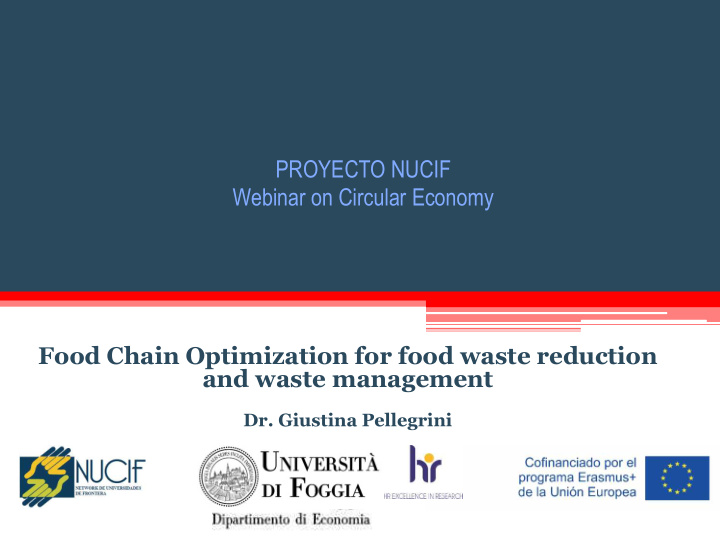



PROYECTO NUCIF Webinar on Circular Economy Food Chain Optimization for food waste reduction and waste management Dr. Giustina Pellegrini
Food waste statistics 54% 53% EU 21% Italy 15% 13% 12% 11% 11% 8% 2% Agricultural Processing Distribution Food Service Household
Food waste statistics 4% 13% 31% 24% 28% Figure 2- Costs of edible food in 2012 across EU-28 Source : our processing data from Stenmarck et al. (2016)
Food waste statistics Figure 3- Foods contributing increase of CO 2 emissions Source: WRAP data (2015)
Food waste statistics Figure 4-Per capita food wastage footprint on climate in different countries Source: Stenmarck et al., (2016)
Food waste management Figure 5- Sustainable waste management Source : Garcia-Garcia et al., 2016
Food waste management To produce functional food To improve technological quality or to extend product shelf life To improve food packaging Figure 6- Waste management and treatment hierarchy Source : Garcia-Garcia et al., 2016
Food waste valorisation 1) Fruit and Vegetable Industry 2) Grain Processing Industry 3) Brewery and Winery Industry 4) Marine Industry 5) Meat Industry 6) Dairy Industry
Food waste valorisation Figure 7-Linear economy vs circular economy Source : our processing on data
Food waste valorisation Figure 8- Food waste valorisation Source : our processing on data
Food waste valorisation
Business models on bio-based: the waste generated during tomatoes’processing PROCESSED PRODUCT FINAL AMOUNT WASTE GENERATED Peeled tomatoes 44% - Pulps; purees 48% - Concentrates 8% -
TYPE OF WASTE B B P P R O C E S S / APPLICATION BENEFITS/CONSIDERATIONS EXTRACTION Tomato skin Bioplastic films Food/agricultural industry High molecular weight, temperature resistance, Business models on bio-based: the waste generated elasticity, viscosity Lycopene extracted Pharmaceutics and cosmetic Antioxidant, antimicrobic, antitumoral, anti-fungal, during tomatoes’processing anti-neurodegenerative, etc.; lycopene higher in the recovered tomato peels rather than processed pulp; cardiovascular and cancer diseases prevention; Fibres from lycopene Pharmaceutics Improving digestion; reduction of glucose and cholesterol levels in blood; Bio-lacquer Metal cans industry (food) Reduced emission of production compared to other lacquers; lower hazardous substances released from the tin; Pectin extracted in two steps Corrosion inhibitors and food Tomato peel good source of pectin with ammonium oxalate/oxalic industry additives acid, under reflux Silage Animal feed Need combination of other organic material to reach good quality of dry matters Mixed with other organic Tyres Reduced env. impact (usual reinforcing material is matters such as egg shells carbon); strengthening qualities; Toasting Biofuels Higher calorific power, higher preservation and homogeneity of the biofuels than more common ligneous material Tomato seeds Oil extracted combined with Pharmaceutics, cosmetics Preventing arteriogenesis; preventing cardiovascular lycopene diseases; T o m a t o w a s t e Anaerobic Digestion Energy production Methane levels higher than using manure only; c o m b i n a t i o n s ; Composting Fertilizers Excellent fertilizing qualities, extirpation of diseases tomato waste & other and organisms harmful to the plants organic matter
Business models on bio-based: the waste generated during tomatoes’processing Actors Prerequisites Benefits Waste isolation Tomato Processers Volumes (can be reached with associations) Access to new Business models Proximity with markets processors Waste Collectors Income Shipping and generation delivery means Increased Transforming Know-how of processing/ networking facilities extraction Know-how on new products Environmental integration sustainability New industries Access to target market
Thank you for your attention contact: giustina.pellegrini@unifg.it
Recommend
More recommend